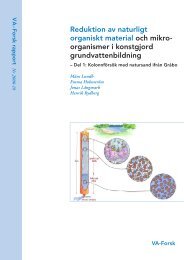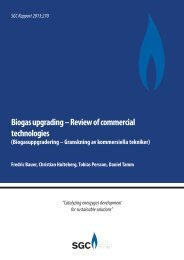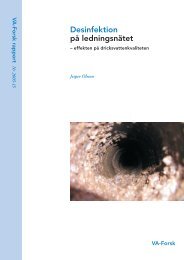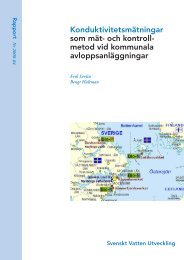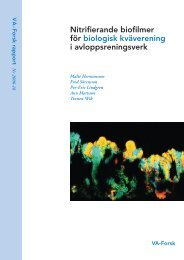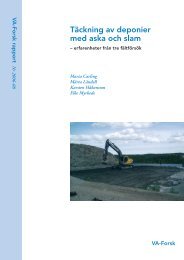Återvinning av vattenverksslam
Återvinning av vattenverksslam
Återvinning av vattenverksslam
Create successful ePaper yourself
Turn your PDF publications into a flip-book with our unique Google optimized e-Paper software.
Summary<br />
When producing drinking water from surface water sources, the most common<br />
treatment method is chemical coagulation and precipitation. In the coagulation<br />
step, an aluminium salt is often added in order to cause impurities such as humic<br />
acids and particles to coagulate and precipitate from the raw water. The treatment<br />
method produces sludge which in addition to the impurities from the raw water<br />
also consists of added precipitation chemical. The problem of handling the sludge<br />
always has to be solved at the waterworks. Sludge causes sometimes a negative<br />
environmental impact.<br />
In order to solve the problem with aluminiumcontaining sludge, a new<br />
process called “the REALprocess” has been tested during a year in pilot scale at<br />
the Hässlö waterworks in Västerås, Sweden. The construction of the pilot plant<br />
and the work during the test period has been carried out as a VAForsk project,<br />
where Mälarenergi AB, Sydvatten AB, Karlskrona municipality, Feralco AB,<br />
University of Lund, Mercatus Engineering AB and Sweco Viak AB participated.<br />
The REALprocess is a recycling process with four steps for aluminium recovery<br />
from waterworks sludge. In the first step, aluminium hydroxide is hydrolysed by<br />
addition of sulphuric acid to the sludge. In the second stage, ultrafiltration (UF)<br />
is utilised for separating all suspended material and macromolecules from the<br />
dissolved aluminium ions. The sludge volume is reduced by the UF approximately<br />
20 times and the sludge contains a very small amount of aluminium. Permeate<br />
from the UF contains the vast part of the aluminium ions. It is led to the third<br />
process step, a nanofilter (NF), where the concentration of the aluminium is<br />
increased. In the fourth step, the aluminium is precipitated by addition of<br />
potassium sulphate, causing the aluminium to form potassium aluminium<br />
sulphate dodekahydrate crystals (alum). The pure salt can be reused as coagulation<br />
chemical in the waterworks. The recovery is approximately 90 %.<br />
The REALprocess is not to be seen purely from an economical point of view,<br />
but also from an ecological, since a solid waste (waterworks sludge) is recycled<br />
as new chemical. Also from an economical point of view, the REALprocess is<br />
keeping up well.



